Cut Didn't Go Through Material
If your print finishes and you find it didn't cut through the material, a few different issues could be the cause. We'll take you through what needs to happen for your Glowforge to print successfully, and help you troubleshoot your setup.
First, your material must lay flat. This requires flat materials and a clean, properly installed crumb tray. Second, optical surfaces must be clean and undamaged. Third, your design must be set up properly: for example, with lines that are fully on the material and that are set to cut (rather than score or engrave).
With those requirements in mind, let's go step-by-step through possible causes.
If the crumb tray is mispositioned or has any stray bits of material from packaging or printing, it could keep your material from lying flat. Even a millimeter difference in height could prevent a clean cut. So let's start by checking the crumb tray.
-
Remove the crumb tray
To remove the crumb tray, lift the lid, then swing down the front door. Lift the crumb tray slightly and slide it toward. Be careful not to tilt the crumb tray up, or it will knock into the printer head and rails. Congratulations, you've removed the crumb tray!
-
Remove all dust and debris from the bottom of your Glowforge
-
Clean the dimples
There are four dimples for the feet of the crumb tray to sit in. Wipe them with a damp tissue or cloth.
-
Empty the crumb tray
There is a slot in front of the crumb tray, under the handle. Point it towards a garbage and shake the tray so that debris falls out. If debris is stuck in the honeycomb, gently push it out. Debris can make the honeycomb uneven, or prevent your material from resting flat against it.
-
Replace the tray
Make sure the tray is facing the right direction and that it's four feet slide into the small dimples. When the four feet drop into place, the tray will no longer slide freely.
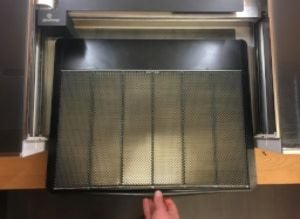
(If your tray is damaged, a new one can be purchased in our shop here.)
Even when the crumb tray is clean and flat, your material may not lay flat. Some materials can develop a curve (called "warp"), and warped material may not yield consistent cuts. The problem is especially likely with large prints.
- Soft materials, like Proofgrade leather may need to be smoothed into place. Any lumps or bumps will affect the print quality.
Your Glowforge has a powerful laser, yet it can be stopped by a tiny amount of dirt or damage to the lens or windows. If something comes between the laser light and your materials, it can keep the laser from cutting.
Here’s how to check for damage and clean your lens and windows at the same time.
-
Remove the printer head
Make sure your Glowforge is turned off. Lift the lid. Grasp the printer head as shown, and pull gently up and back to disengage the magnets and remove it.
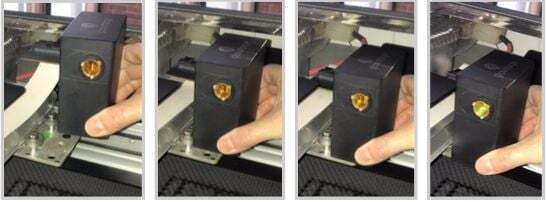
-
Remove the lens
- With the "Remove" arrow pointed in, gently insert the lens tool into bottom of the printer head. When you hear the magnet click, remove the tool and the lens.

- Look at the lens on the tool. It should be resting on top of the tool like a bowl, with the top open and with the orange-colored optics on the bottom. If it’s upside down, it won’t work properly.

- Gently slide the lens off the lens tool. Be careful to touch only the metal ring to avoid fingerprints on the lens.
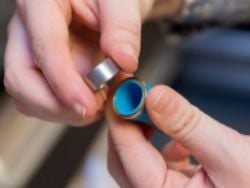
- With the "Remove" arrow pointed in, gently insert the lens tool into bottom of the printer head. When you hear the magnet click, remove the tool and the lens.
-
Check for scratches or dirt
- Check the lens for fingerprints, dirt or scratches. If you see a scratch, you can order a new lens in the Glowforge shop.
- Wipe both sides of the lens with a Zeiss lens wipe.
-
Re-insert the lens
If the lens appears clean, you can put it back.
- Flip the lens tool so that the “Install” arrow points up. Set the lens down on the lens tool. The open side faces away from the blue plastic, so it looks like a bowl on top of the tool. It will sit firmly on the tool and will not wiggle. Slide the lens tool up into the printer head until the magnet clicks, then remove the tool.
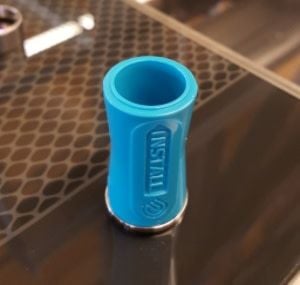

-
Replace the printer head
Review instructions for snapping in your printer head, then put the head back on.

-
Inspect the printer head windows and the laser window
- Check the printer head windows for damage. One window is on the left side of the printer head, and another is just over the left rail. Shining a flashlight at an angle onto the window may help you to see more clearly.
- If you see damage, replacement printer head windows can be purchased here, and replacement laser windows can be purchased here.
- If you're unsure whether you need to replace either window, please contact our team and we'll be happy to help!
- Otherwise, wipe the window clean with a Zeiss wipe.
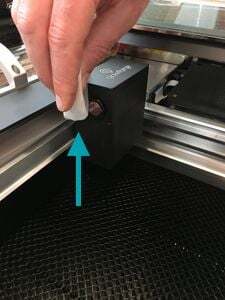
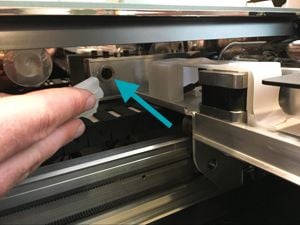
Finally, let's make sure your design is set to cut.
On the left side in the Glowforge App (app.glowforge.com), you should see a list of the shapes that make up your design. At least one should be labeled "Cut," with a small scissors icon beneath it. (See below for an example.) In the design space, this shape should appear in red, rather than gray.
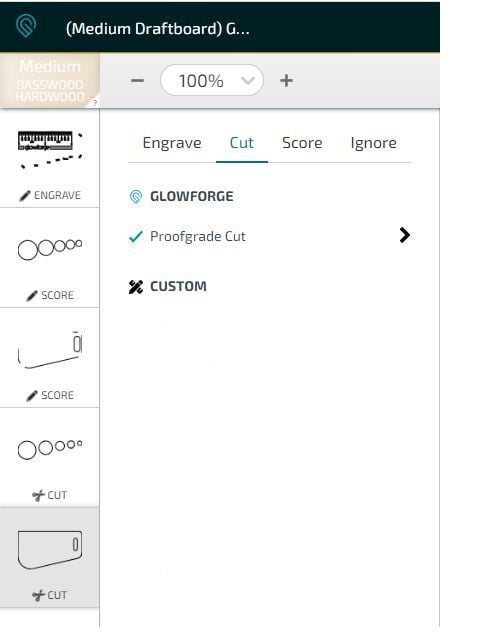
Shapes that you want to cut need to have a stroke (an outline) but no fill (color in the middle). For step-by-step instructions, have a look at the Gift Tag tutorial.
- If the step you want cut is not set to cut, click on the step and choose “Cut.”
- Make sure you've loaded a piece of Proofgrade material with the QR code in the corner clearly visible or that you've selected the matching material in the top-left.
- Make sure the object that you wish to cut does not touch the grey edges of the work area.
Once you've confirmed that your design is properly set to cut, try your print again.
Want help with cut through?If your Proofgrade material didn’t cut through with default settings, contact Glowforge Support and give us:
- A description of the steps you took, what happened and what you expected.
- A description of other recent prints – is this the only one you’ve had trouble with?
- The date, time, and/or name of your print.
- Photos of the front, back, and sides of the print.
- We included an extra piece of Proofgrade Draftboard with your materials shipment for troubleshooting. If the issue is new, please print the Gift of Good Measure on Proofgrade Draftboard and let us know the result.